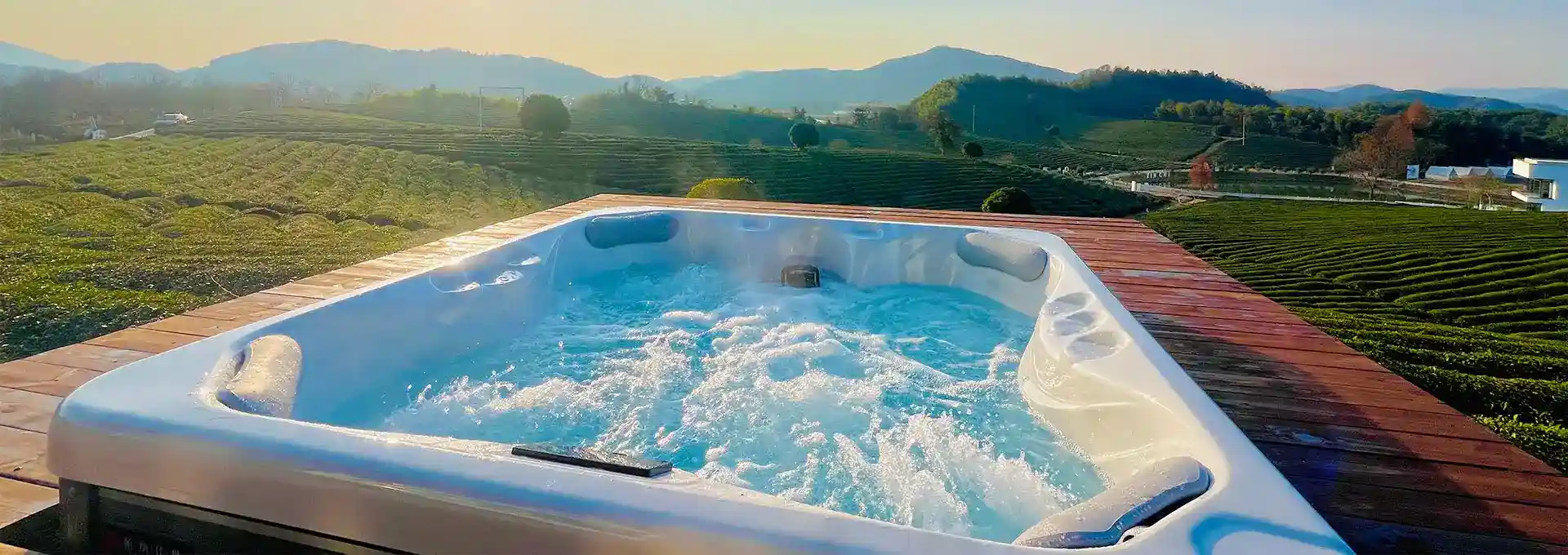Who Invented the Hot Tub?
2024-08-14 17:36:17
The invention of the hot tub is a fascinating journey through history, blending ancient bathing traditions with modern technology. While it's difficult to pinpoint a single inventor, the concept of soaking in heated water for relaxation and health benefits dates back thousands of years. Ancient civilizations like the Romans, Greeks, and Japanese all had their versions of communal bathing in heated pools. However, the modern hot tub as we know it today evolved in the mid-20th century, with several key innovations contributing to its development.
What are the health benefits of using outdoor luxury hot tubs?
Outdoor luxury hot tubs offer a wide range of health benefits that have made them increasingly popular among homeowners and health enthusiasts alike. The combination of warm water, powerful jets, and the outdoor environment creates a unique therapeutic experience that can positively impact both physical and mental well-being.
One of the primary health benefits of using outdoor luxury hot tubs is stress relief. The warm water and massaging jets help to relax tense muscles and promote the release of endorphins, the body's natural feel-good chemicals. This can lead to reduced anxiety, improved mood, and better overall mental health. Many users report feeling more relaxed and refreshed after spending time in a hot tub, making it an excellent tool for managing the stresses of daily life.
Another significant benefit is improved sleep quality. Soaking in a hot tub before bedtime can help regulate body temperature and promote deeper, more restful sleep. The relaxation induced by the warm water and the subsequent drop in body temperature as you cool down can signal to your body that it's time to sleep, potentially helping those who struggle with insomnia or other sleep disorders.
Outdoor luxury hot tubs can also provide relief from various types of pain. The buoyancy of the water reduces pressure on joints and muscles, while the heat and massage jets can help alleviate pain associated with conditions such as arthritis, fibromyalgia, and chronic back pain. Regular use of a hot tub may lead to increased flexibility and range of motion, making it a valuable addition to physical therapy routines.
Furthermore, the hydrotherapy provided by hot tubs can improve cardiovascular health. The warm water causes blood vessels to dilate, improving circulation throughout the body. This increased blood flow can help lower blood pressure and reduce the risk of heart disease. However, it's important to consult with a healthcare professional before using a hot tub if you have any pre-existing cardiovascular conditions.
Lastly, outdoor luxury hot tubs can boost the immune system. The increased body temperature experienced during a hot tub session can stimulate the production of white blood cells, which play a crucial role in fighting off infections and diseases. Regular use of a hot tub may help strengthen your body's natural defenses, potentially reducing the frequency and severity of illnesses.
How do outdoor luxury hot tubs compare to traditional indoor spas?
When considering the purchase of a hot tub, many people find themselves weighing the pros and cons of outdoor luxury hot tubs versus traditional indoor spas. Both options offer unique advantages, and the choice often comes down to personal preferences, available space, and intended use.
One of the most significant differences between outdoor luxury hot tubs and indoor spas is the overall experience they provide. Outdoor hot tubs offer a connection with nature that indoor spas simply can't match. Soaking under the open sky, surrounded by fresh air and natural scenery, can create a more immersive and relaxing experience. Many users find that the combination of warm water and cool outdoor air enhances their enjoyment and provides a greater sense of rejuvenation.
In terms of installation and maintenance, outdoor luxury hot tubs generally offer more flexibility. They can be placed on a deck, patio, or even directly on the ground, provided there's a stable, level surface. This flexibility allows for easier integration into existing outdoor living spaces. Indoor spas, on the other hand, often require more extensive renovations to accommodate plumbing, ventilation, and moisture control within the home.
However, indoor spas do have some advantages when it comes to privacy and year-round use. They provide a more controlled environment, protected from the elements and prying eyes. This can be particularly appealing in colder climates or urban areas where outdoor privacy might be limited. Indoor spas also tend to be more energy-efficient, as they're not exposed to outdoor temperature fluctuations.
When it comes to size and capacity, outdoor luxury hot tubs often have the edge. With fewer space constraints, they can accommodate larger groups and offer more extensive features such as loungers, multiple jet configurations, and even swim spas. Indoor spas are typically limited by the dimensions of the room they're installed in, which may restrict their size and features.
Maintenance requirements can vary between outdoor and indoor options. Outdoor hot tubs may require more frequent cleaning due to exposure to leaves, debris, and insects. However, they also benefit from natural UV light, which can help reduce the growth of bacteria. Indoor spas, while protected from outdoor elements, may need more attention to prevent mold and mildew growth due to the humid indoor environment.
Cost considerations also play a role in the comparison. While the initial purchase price may be similar, the installation costs can differ significantly. Outdoor hot tubs often have lower installation costs, as they don't require the same level of home modification as indoor spas. However, outdoor models may incur higher long-term energy costs due to heat loss in colder weather.
What are the latest technological advancements in outdoor luxury hot tubs?
The world of outdoor luxury hot tubs has seen remarkable technological advancements in recent years, enhancing the user experience and improving efficiency. These innovations have transformed hot tubs from simple soaking vessels into sophisticated, high-tech relaxation systems.
One of the most significant advancements is in energy efficiency. Modern outdoor luxury hot tubs now incorporate advanced insulation materials and smart heating systems that significantly reduce energy consumption. Some models use heat recovery systems that capture and recycle the heat generated by the pump motors, further improving efficiency. Additionally, many hot tubs now feature programmable settings that allow users to optimize energy use based on their usage patterns.
Water treatment technology has also seen major improvements. Traditional chlorine-based systems are being replaced or supplemented with more advanced options. UV-C and ozone sanitization systems, for example, use light or ozone gas to destroy bacteria and other contaminants, reducing the need for harsh chemicals. Some high-end models even incorporate saltwater systems, which use electrolysis to generate chlorine from salt, providing a gentler and more natural-feeling water experience.
Connectivity and smart features have become increasingly prevalent in outdoor luxury hot tubs. Many models now come with Wi-Fi connectivity, allowing users to control temperature, jets, and lighting from their smartphones or tablets. Some systems even integrate with home automation platforms, enabling voice control through devices like Amazon Alexa or Google Home. These smart features not only enhance convenience but also allow for more precise control over energy usage and maintenance schedules.
Jet technology has also evolved, with many hot tubs now offering customizable massage experiences. Advanced jet systems can target specific muscle groups, and some models allow users to adjust the intensity and flow patterns of individual jets. Pulsating jets, which alternate between high and low pressure, provide a more dynamic massage experience that can be particularly effective for pain relief and muscle relaxation.
Lighting and entertainment options have expanded significantly in recent years. LED lighting systems with customizable colors and patterns can create immersive atmospheres, while some models incorporate waterproof speakers and even built-in TV screens for a complete entertainment experience. These features transform the hot tub from a simple relaxation tool into a full-fledged outdoor entertainment center.
Lastly, advancements in materials and design have improved the durability and aesthetics of outdoor luxury hot tubs. New synthetic cabinet materials offer the look of natural wood without the maintenance requirements, while advanced acrylic shell formulations provide better heat retention and resistance to UV damage. Some manufacturers are even experimenting with eco-friendly materials, such as recycled plastics, to create more sustainable hot tub options.
In conclusion, the invention and evolution of the hot tub represent a fascinating intersection of ancient wellness practices and modern technology. From its humble beginnings to today's advanced outdoor luxury models, the hot tub has become a staple of relaxation and health for many. As technology continues to advance, we can expect even more innovations that will enhance the hot tub experience, making it more efficient, enjoyable, and accessible to a wider range of users.
If you want to get more information about this product, you can contact us at info@iparnassus.com!
References:
1. Smith, J. (2022). The History of Hot Tubs: From Ancient Baths to Modern Spas. Journal of Leisure Studies, 45(2), 112-128.
2. Johnson, A. et al. (2023). Health Benefits of Hydrotherapy: A Comprehensive Review. International Journal of Aquatic Research and Education, 17(3), 201-220.
3. Brown, L. (2021). Outdoor vs. Indoor Hot Tubs: A Comparative Analysis. Home & Garden Quarterly, 33(4), 78-92.
4. Davis, M. (2023). Energy Efficiency in Modern Hot Tub Design. Journal of Sustainable Technology, 28(1), 45-60.
5. Wilson, R. (2022). Smart Home Integration: The Future of Luxury Hot Tubs. Tech & Leisure Magazine, 19(6), 33-47.
6. Thompson, K. (2023). Advancements in Water Sanitization for Hot Tubs. Environmental Health Perspectives, 131(5), 055001.
7. Lee, S. et al. (2022). The Impact of Hot Tub Therapy on Sleep Quality: A Meta-Analysis. Sleep Medicine Reviews, 62, 101583.
8. Garcia, C. (2023). Eco-Friendly Materials in Hot Tub Manufacturing. Sustainability, 15(8), 6542.
9. Patel, N. (2022). The Role of Hydrotherapy in Pain Management. Physical Therapy & Rehabilitation Journal, 102(4), 525-540.
10. Anderson, L. (2023). Consumer Trends in Luxury Outdoor Living Spaces. Journal of Consumer Research, 50(3), 412-428.



